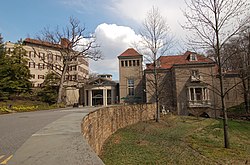Winterthur Museum, Garden and Library
|
Winterthur Museum, Garden and Library
|
|

The Museum building
|
|
| Location | Winterthur, Delaware |
|---|---|
| Coordinates | 39°48′21″N 75°36′3″W / 39.80583°N 75.60083°WCoordinates: 39°48′21″N 75°36′3″W / 39.80583°N 75.60083°W |
| Area | 979 acres (396 ha) |
| NRHP Reference # | 71000233 |
| Added to NRHP | February 24, 1971 |
Winterthur Museum, Garden and Library is an American estate and museum in Winterthur, Delaware. As of 2011[update], it houses one of the most important collections of Americana in the United States of America. It was the former home of Henry Francis du Pont (1880–1969), a renowned antiques collector and horticulturist. Until recently, it was known as the Henry Francis du Pont Winterthur Museum.
In the early 20th century, H. F. du Pont and his father, Henry Algernon du Pont, designed Winterthur in the spirit of 18th- and 19th-century European country houses. The younger du Pont added to the home many times thereafter, increasing its number of rooms by nearly sixfold. After he established the main building as a public museum in 1951, he moved to a smaller building on the estate.
Winterthur is situated on 979 acres (396 ha), near Brandywine Creek, with 60 acres (24 ha) of naturalistic gardens. It had 2,500 acres (1,000 ha) and a premier dairy cattle herd when du Pont operated it as a country estate.
Initially a collector of European art and decorative arts in the late 1920s, H. F. du Pont became interested in American art and antiques. Subsequently, he became a highly prominent collector of American decorative arts, building on the Winterthur estate to house his collection, conservation laboratories, and administrative offices.
The museum has 175 period-room displays and approximately 85,000 objects. Most rooms are open to the public on small, guided tours. The collection spans more than two centuries of American decorative arts, notably from 1640 to 1860, and contains some of the most important pieces of American furniture and fine art. The Winterthur Library includes more than 87,000 volumes and approximately 500,000 manuscripts and images, mostly related to American history, decorative arts, and architecture. The facility also houses extensive conservation, research, and education facilities.
...
Wikipedia

